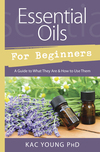5 Ways to Battle Colds and the Flu with Essential Oils

You've heard the phrases "nip it in the bud" and, "a stitch in time;" well, they are pertinent to both the cold and flu—the time to act is when you first feel the symptoms coming on. I've put together some tips for you that will help you the minute you feel you might be getting something. It's always a good idea to nip it in the bud before it becomes a full-fledged bloom. Carry a few of these essential oils with you during the months when we are susceptible to airborne or contact germs: Lemon, Eucalyptus, Tea Tree, and Peppermint are easy to find, excellent to have on-hand, and effective to stop germs in their tracks.
1. Sore Throat Symptoms:
If you feel a sore throat coming on, break out the Lemon essential oil. Airborne Lemon essential oil will disinfect and sanitize your nasal, sinus, and throat areas. The best ways to use Lemon essential oil are in an inhaler that you can make yourself, in a diffuser, or even a few drops on a cotton ball inhaled for 20-30 seconds over a 3-minute period. Never ingest.
2. Runny or Stuffy Nose
If you have a runny or stuffy nose, break out the Eucalyptus, Tea Tree, and Peppermint essential oils. Blend a few drops (one drop each, for 3 drops total) in a diffuser and breathe in the healing moisture. You can also use an inhaler that you make yourself, or again, a few drops on a cotton ball inhaled will help ease the discomfort and hasten your recovery. Never ingest.
3. Congestion
Eucalyptus is an effective anti-congestion essential oil. Diffuse in your room to fight infections and clear the lungs. Tea tree and Peppermint essential oils are also effective for breaking up congestion and opening the lung and bronchial passages. Use a blend of these in a diffuser, in an inhaler, or on the cotton ball (which you can keep in a small plastic container or a snack bag). Refresh as needed and inhale frequently to relieve symptoms and discomfort.
4. Cough
Peppermint is effective to help ease a cough. It has anti-spasmodic qualities, which can ease the mucus tissue and reduce cough spasms. It contains menthol, which can open the airways to provide breathing relief. Diffuse Peppermint essential oil or mix it with a carrier oil and apply to your chest. Never ingest.
5. Sneezing and Allergies
If you are affected by seasonal allergies, Frankincense essential oil can soothe your discomfort by supplying anti-inflammatory qualities to open up and ease inflamed airways cause by reactions to pollen and sinus irritation. Lavender also calms the airpaths and relaxes the sneeze reflexes. Eucalyptus essential oil provides a big boost to the inhalation system, and with its antibacterial benefits can kill germs and mold in the air. Use these oils separately or together in a diffuser, in inhalers, or on a cotton ball for easy transport and access.
Prevention
One of the best things you can do to prevent contact transfer of contagious germs is to carry with you, and use, a hand sanitizer. I'm not recommending the ones you buy already premade. I'm suggesting that your most effective hand sanitizer is the one you make yourself. Go ahead and purchase the OTC hand sanitizer bottles, then (in an environmentally sensitive manner) dispose of the contents. Wash out the bottle and fill it with aloe vera gel. Add to that 3 drops of Lemon and three drops of Tea Tree, Eucalyptus, or Lavender Essential Oils, depending on your aromatic preference. Shake it well to combine. The gel will turn slightly cloudy, and that's good. Shake it every now and then to keep the mixture blended. Use this on your hands when you are shopping, out in public places, in a restaurant, or anywhere you touch doorknobs, handles, railings, or commonly used items. The more you use this self-made hand sanitizer, the softer your hands will feel in the winter and the more protected you will be throughout the season when we are more vulnerable to the spread of viruses.
Notes on Using Essential Oils
- Be sure to buy and use only wild-crafted, 100% pure or organic essential oils. Other oils without these labels can contain pesticides and toxins. Use only the purest of essential oils for your body.
- Dilute any and all essential oils you use on your body. Never use them straight from the bottle. Dilution charts are available on the Internet.
- Never ingest essential oils. They can cause harm if swallowed.
- When diffusing, make sure children, the elderly, and pets are not in the room. Their lungs and tissues are tender and could be damaged by potent essential oils. Diffuse up to 20 minutes, rest 20 minutes, and then repeat up to 4 times.
- Inhalers are easy to make. Order DIY supplies online or find them in your local health food store.

About Kac Young PhD
Related Products

is subject to certain Terms and Conditions